Did you know that Pumas are one of America’s most widely available mammals? Moreover, what makes them more fascinating is their hunting and social skills. While they are often regarded to be lone hunters, they can also hunt in groups depending on the availability of prey.
In fact, Pumas are moderate social animals and are known for maintaining long-term relationships among themselves. This also includes mating and parenting.
It needs not to be said that Pumas are incredible animals. And in this article, we’ll take a deeper dive into their behavioral factors, habits as well as ecological adaptations, and social behavior. So, tag along!
Chart: Behavioral Facts of Puma
Before we take a deeper dive, here’s a chart to show their core behavioral traits!
| Habits and Behaviors | Description |
|---|---|
| Growing Habits: | From infancy to old age, pumas experience physical and structural modifications such as hearing development and marking behavior. |
| Feeding Habits: | Pumas hunt alone and use a variety of methods to obtain prey, such as stalking and ambushing. They may share kills with family members and utilize scent marking to show who owns a kill. |
| Breeding and Migration Patterns: | During the mating season, pumas may engage with one another and create territories to secure a consistent supply of food. They may also move to track prey populations. |
| Aggression and Territorial Habits: | Pumas defend their territory and resources by using vocalizations and scent markings. If they believe their safety or resources are endangered, they may become aggressive against other predators. |
| Ecological Adaptation: | Pumas are adaptive to their surroundings and may create territories in a variety of habitats, including mountains, deserts, and woods. They are crucial in managing predator-prey interactions and preserving ecological equilibrium. |
| Social Behavior: | Pumas are usually solitary animals, although, under specific conditions, they may display social behaviors like communication, resource sharing, and familial bonding. |
Why Do Pumas Behave Significantly?
Pumas have been around the Americas for millions of years. And while they used to be found all over the place, their habits have decreased over time.
Their significant behavior is essential for the survival and continuation of their breed.
Significance of Understanding the Diversified Behavior of Pumas
Like most wildlife, pumas have also been victims of various human activities. It is essential to maintain their population and diversity to sustain the ecosystem.
Moreover, understanding their diverse behaviors help us to educate ourselves about their importance. As well as the need to be more cautious when preserving nature and wildlife.
Growing Habits: Structural & Physical Adaptations
From being a cub to their old age, Pumas grow various habits throughout their lifespan. Moreover, they sustain different physical adaptations as per their environment. Let’s check their growing-up habits!
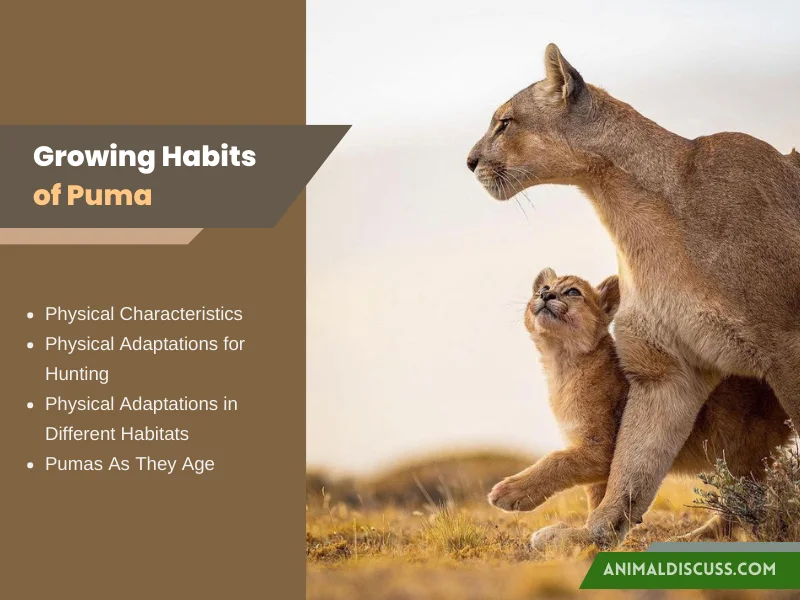
Growing from Cubs to Adults
Like other cats, pumas go through various physical adaptations through different stages of their life!
Cub: Puma cubs are born blind and defenseless, with their eyes opening after around two weeks. They depend on their mother’s milk for sustenance and protection during this period. These cubs also have spotted coats that help them hide from predators.
Kitten: At this time, they start eating solid food and learning how to hunt from their mother. Their teeth begin to form, and they begin to investigate their environment. As kittens, pumas retain their spotted coat.
Juvenile: At this stage, they begin to go out on their own and grow increasingly self-sufficient from their mother. They get adult teeth and their vision and hearing develop properly. Their spotted coat begins to diminish at this time, and they grow a more uniform coat color.
Sub-Adult: Sub-adult pumas are still learning to hunt and are not completely self-sufficient. They keep growing and developing their adult coat, which is generally tawny or reddish-brown in color. Their tail lengthens and thickens, and they begin to acquire a more muscular body.
Adult: Adult puma has completely perfected their hunting abilities and is self-sufficient. They are robust and athletic, having strong legs for sprinting and leaping. With the exception of mating and rearing pups, they are generally solitary creatures.
Physical Characteristics
Size and Weight: In Northern America, the males can weigh 100-150 pounds (45-68 kg), while females weigh between 64-141 pounds (29-64 kg). And they can grow up to 9 feet tall.
While in the South, the males weigh between 100-150 pounds (45-68 kg), while females weigh between 64-100 pounds (29-45 kg). Also, they are slightly shorter, around 8 feet in length.
Color: In general, pumas have tan or reddish-brown coated fur, which is usually very short and sleek. However, some breeds may develop slightly greyer or black fur.
Nonetheless, all pumas have a light-colored chest and markings on their face, with an iconic line stretching from their eyes to their mouth.
Paws: Like most wild cats, pumas have padded paws with retractable claws. Their front paws have five toes, while the rear ones have only four.
Eyesight and Hearing Ability: Pumas also have a tapetum lucidum, a reflective coating at the rear of their eyes that helps them see in dim light. Moreover, they can hear noises that are outside the range of human hearing, including certain prey species’ ultrasonic vocalizations.
Physical Adaptations for Hunting
There are a few physical attributes that contribute to their hunting and feeding habits. These feeding adaptations include:
- The jaw and teeth: Pumas have strong jaws and fangs that they employ to deliver a lethal bite to the neck or throat of their victim. Their teeth are designed for piercing and slicing, and their jaw muscles may crush bones.
- Spine flexibility: Pumas have a flexible spine that permits them to hunt in tight quarters and on tough terrain.
- Camouflage and stealth: Pumas have acquired natural stealth and camouflage, allowing them to blend in with their environment and avoid prey and predators.
Physical Adaptations in Different Habitats
Pumas in the Northern Americas are generally bigger and stronger than those found in the South. This is due to the north being more mountainous and consisting of more difficult habitual situations. Moreover, they have to prey on larger animals to survive.
The pumas in the south live mostly in the forest and are known to hunt smaller prey. Thus, their physicality does not require them to be big and strong but rather sleek.
Pumas As They Age
Like most animals, pumas tend to grow weaker with time. In general, they live up to 20 years. But they see a decline in their physical abilities with time and become vulnerable to diseases or threats in the wild.
Feeding Habits Of A Puma
In general, Pumas are carnivores with a varied diet that depends on several factors. This includes their habitat, availability of livestock, and hunting habits.

Feeding Habits
Pumas will often drag their victim to a quiet spot after killing it to escape competition from other predators. They may consume many meals from a single prey item, beginning with the most nutritious components, such as the organs and muscles.
Pumas are also known to cover their kills with leaves and dirt to keep scavengers at bay.
Hunting Strategies
Pumas are solitary hunters that utilize ambush and stealth to grab their prey. They follow and surprise their target before delivering a devastating bite to the neck or throat, relying on their exceptional vision, hearing, and sense of smell.
Pumas may also change their hunting techniques in response to prey availability and local circumstances.
Providing Food for Offspring
Eventually, the young cubs are fed completely on their mother’s milk. Afterward, the mother may often stockpile kills near their dens to offer a consistent supply of food for their offspring.
As the cubs mature, they will accompany their mother on hunts, where they also learn to prey on their own. However, the majority of cubs perish before they can feed themselves.
Breeding (Mating) Habit & Migration Patterns
American pumas date back 8 million years. Due to urbanization and other human activities, they have become less widespread across the area.
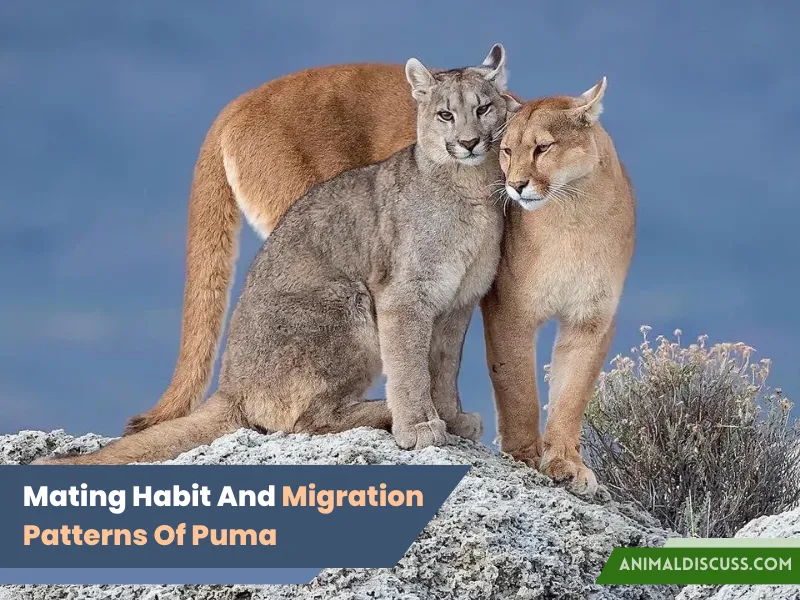
However, their breeding habit makes them sustainable to this date.
Mating season: Pumas breed throughout the year. However, the primary mating season starts early winter till late spring, when they may interact every 11-12 days.
Courtship: Male pumas will produce loud vocalizations to attract females during mating season. Moreover, scent marking is used by both male and female pumas to announce their presence and attract possible mates.
They may pee, defecate, or rub their scent glands on trees or other things to expel their aroma.
Breeding Process: When males and females meet, they may participate in a courting ritual that includes sniffing, grooming, and rubbing against one another. This aids in the formation of a link between the two animals.
Gestation Period: Pumas have a gestation period of about 90 days, and the female can reproduce up to 6 cubs at a time. Furthermore, they are known to preserve their genetic diversity through migrating.
Ecological Adaptation Of Puma
Pumas are apex predators and perform an important role in the ecosystem. Especially managing prey species numbers and maintaining a healthy balance of species variety.
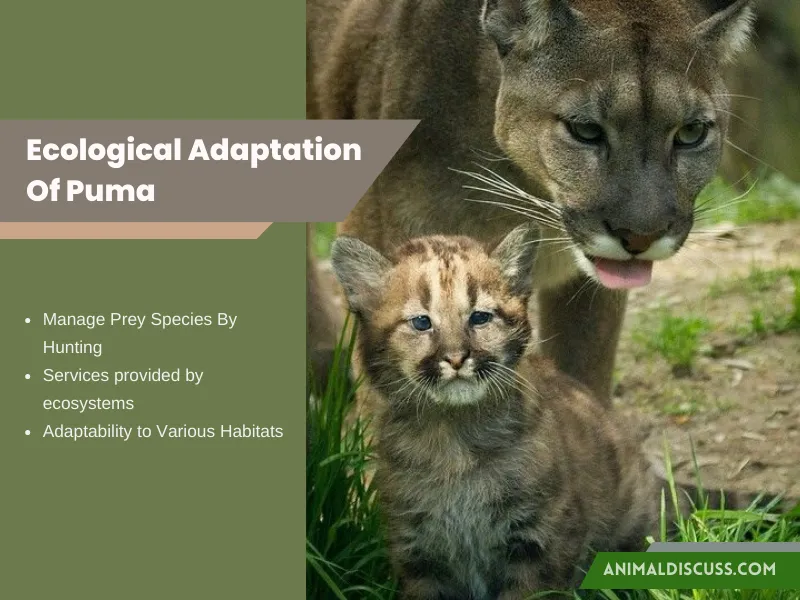
Manage Prey Species By Hunting
Pumas are solitary hunters that utilize ambush and stealth to grab their prey. They assist in managing herbivore populations, such as deer and elk, and a variety of prey species.
Pumas also scavenge on carrion, lowering the likelihood of disease outbreaks and preserving the ecosystem’s nutrient cycle equilibrium.
Services provided by ecosystems
Pumas provide a variety of environmental services, including seed distribution and nutrient cycling. They consume a variety of food, including rodents and other small animals, which may help disperse plant seeds over their habitat.
Pumas also contribute to nutrient cycle equilibrium by scavenging on carrion and transferring nutrients throughout the environment.
Adaptability to Various Habitats
Pumas have shown extraordinary adaptation to a wide range of settings. Because of their versatility, they may take advantage of various prey availability and adapt to changing environmental circumstances.
Aggression and Territorial Habits
In the Americas, Pumas are essential for maintaining the predator-prey dynamics and sustaining the species’ population. They have specific traits for aggression towards intruders as well as other territorial habits.

Aggressive Nature of Puma
Pumas become aggressive during the mating season as they perceive other males as a threat to their territory or mating partner. Moreover, they can also become aggressive when food is scarce.
In general, mother pumas are protective of their offspring and can show aggressiveness for their protection. Moreover, they can be aggressive to any threat, like humans, to their habitat.
Territorial Behavior of Pumas
Pumas utilize scent marking and vocalizations to protect their territory and alert other Pumas to their presence. They may also use scratch marks on trees or rocks to signify ownership and discourage other Pumas from invading their area.
During mating season, when males and females may struggle for resources and breeding territory, territorial behavior is more crucial. At the time, males may vocalize to defend their territory and attract females.
At the same time, mothers may shift their pups to various dens to protect them from other predators or males.
Predator
Pumas are apex predators, which means they are at the top of the food chain and have few natural predators. However, they may compete for resources like food or territory with other predators such as wolves, bears, or coyotes.
They may be aggressive against other predators in their environment, especially when they feel threatened. Moreover, if confronted with other predators, Pumas may exhibit aggressive behaviors like growling, hissing, or snarling.
They may even attack if their safety or resources are endangered. Pumas, on the other hand, seek to avoid conflict whenever possible since they are solitary creatures that prefer to hunt and live alone.
Prey-Dynamics
Puma territorial behaviors towards prey dynamics are critical for maintaining predator-prey balance and managing prey species numbers. Their territorial behavior aids in the regulation of prey species populations by assuring a consistent supply of food and healthy population size.
Pumas serve to avoid overgrazing of vegetation and maintain a healthy balance of species variety in the environment. They do this by regulating populations of prey species like deer and elk in their habitats.
Social Behavior
In general, pumas are solitary animals. However, they do share some social traits under the circumstances.
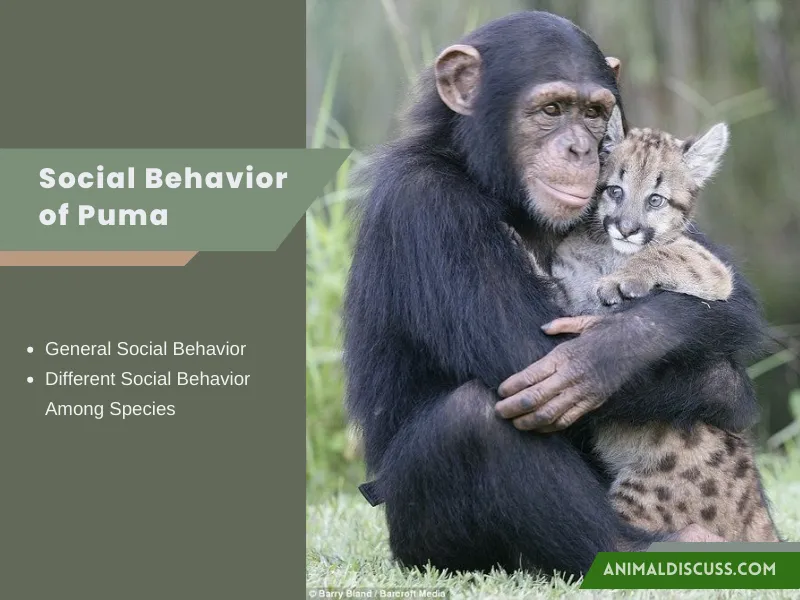
General Social Behavior
Pumas become the most social during mating season. Like most other bigger cat species, pumas communicate by hissing and growling.
Moreover, they can form good family bonds, particularly between a mother and her offspring. Mothers are often very protective of their offspring till a certain age.
Different Social Behavior Among Species
While pumas in both the north and the south share a similar social trait, their environment may lead to some distinctions.
The Southern pumas, living in more open grassland, usually have a greater range of travel. Thus, allowing them more frequent interactions with others of their kind.
Furthermore, the availability of prey and other resources can have an effect on social behavior as well. Also, the competition for resources can lead to greater aggressive behavior against other pumas.
Influence Of Different Behavioral Traits On Puma
The surroundings and environment can change the behavior of any being significantly. And the case is no different for Puma as well. Let’s look at some of the different influences on Puma’s behavioral traits.
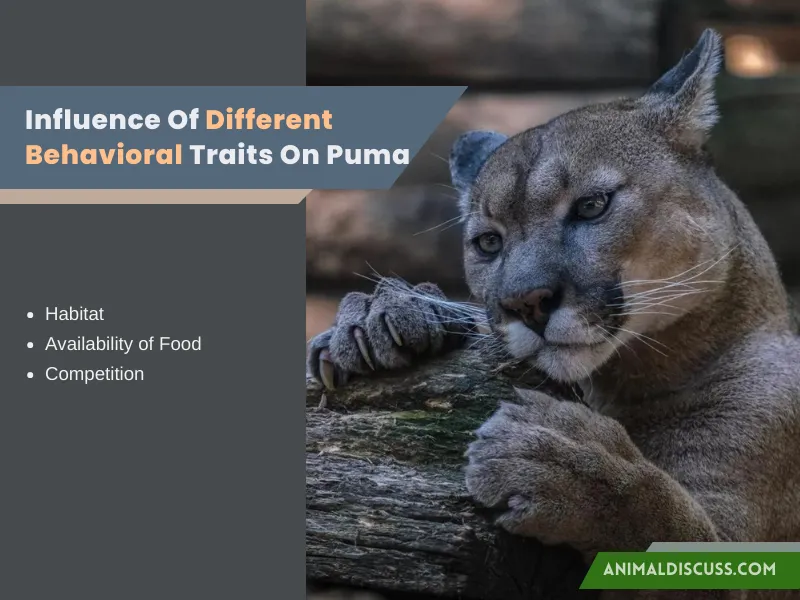
Habitat
The habitat in which a puma lives has the biggest effect on its behavioral traits. As mentioned earlier, pumas have different physical attributes in the northern and southern regions of America.
Likewise, pumas that live in the mountains are more agile, whereas those who live in grasslands are known for their speed and stealth.
Availability of Food
Pumas live in the wild, and their hunting behavior is heavily dependent on the availability of livestock. While they tend to hunt alone, when in need they can hunt in groups and target bigger animals in their ecosystem.
Competition
Pumas also develop competitive aggression when faced with a threat from other wild animals or one of their own. This behavioral trait is also seen when food is scarce. However, Pumas tend to be protective of their territory from outsiders.
Human-Induced Facts That Change Puma Behavior
Human activities have affected wildlife in many segments throughout the years. Likewise, Pumas go through many adjustments because of human influence. And this undoubtedly affects their behavior as well.
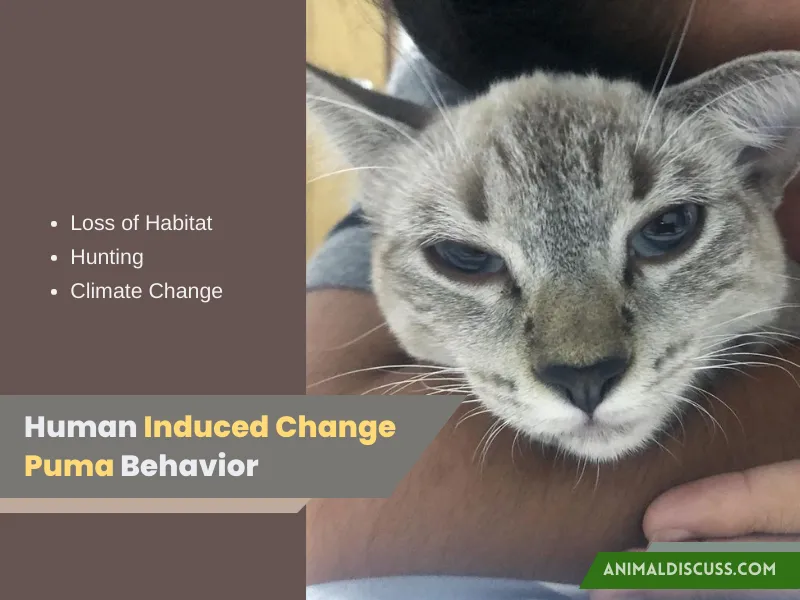
Loss of Habitat
Deforestation, logging, or just urbanization has pushed several animals like puma from their natural habitat. This comes with the difficulty of finding food and shelter and has a significant effect on their behavior for survival.
Hunting
Illegal hunting of wildlife has also affected the pumas in a great manner. The animals now need to be more cautious as well as more aggressive to an unwanted disturbance in their natural habitat.
Climate Change
Human-induced activities that affect the climate eventually have a drastic effect on wildlife as well. These climate changes affect and alter the availability of food for pumas. These also, in case, make them migrate from where they are supposed to be. Overall causing a significant change in their survival habits.
Conservation Of Pumas’ Behavior
Pumas are iconic species, and as humans, it is our responsibility to protect both them and their natural traits. Likewise, there are a few ways we can help preserve their traits in nature.
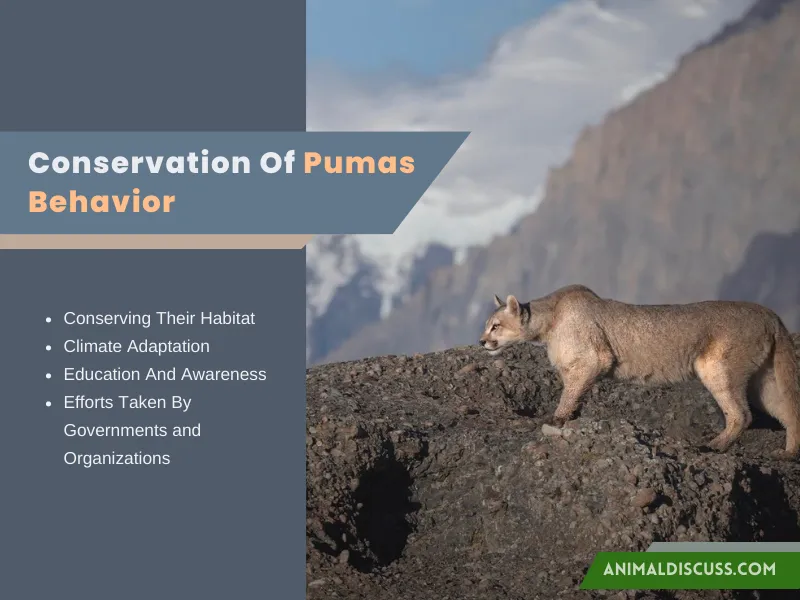
Conserving Their Habitat
The best way to conserve pumas is by making sure we keep them in their natural habitat. Thus we need to protect the mountains and forests from urbanization or other causes of human activities.
Climate Adaptation
As previously discussed, deforestation and the emission of harmful gasses have led puma to dislocate and adapt to a life away from their natural habitat. With collaborative work, the effect of the climate can be reduced significantly.
Education And Awareness
It is important to educate ourselves on the vitality of ecological balance. Through proper education and guidelines, we can help prevent the illegal hunting of pumas and other wildlife.
Securing not only the species but also other wildlife whose absence can cause a disruption in the ecosystem. Ultimately affecting the behavior and habit of animals like the puma.
Efforts Taken By Governments and Organizations
The government and NGOs throughout America have been successfully working to protect wildlife, including that of pumas. Two of the standout work, among many others, are:
- The Wildlife Conservation Society (WCS) and the government of Argentina have collaboratively created and maintained the Patagonia National Park. This is a protected national park where they have taken refuge in various wildlife, including puma.
- The Mountain Lion Foundation is a non-profit organization based in the US. Together with the government they outreach programs and educational initiatives to dispel misconceptions about pumas and foster understanding of their role in ecosystems.
Conclusion
The article covered several behavioral facts about puma. Moreover, a deep look into their interesting feeding, mating, and social habits. And also how they differ at either end of America.
Their characteristics influence interactions between predators and prey, ecological balance, and species diversity. Understanding and conserving these species’ innate characteristics is crucial to their survival. To maintain a healthy ecosystem, we must protect their natural surroundings.
Lastly, to help their unique behavioral features, we need to educate ourselves and also spread awareness. Moreover, pumas are not the only animal that requires preservation. If you’re interested in more animals and their habitats, food, and diet, check us out!
References:
- https://www.jstor.org/stable/26869206
- https://www.sciencedirect.com/topics/agricultural-and-biological-sciences/puma
- https://www.britannica.com/animal/puma-mammal-species
- https://bioone.org/journals/wildlife-biology/volume-2021/issue-4/wlb.00875/Habitat-diversity-influences-puma-Puma-concolor-diet-in-the-Chihuahuan/10.2981/wlb.00875.full
- https://www.sciencedirect.com/topics/agricultural-and-biological-sciences/puma

